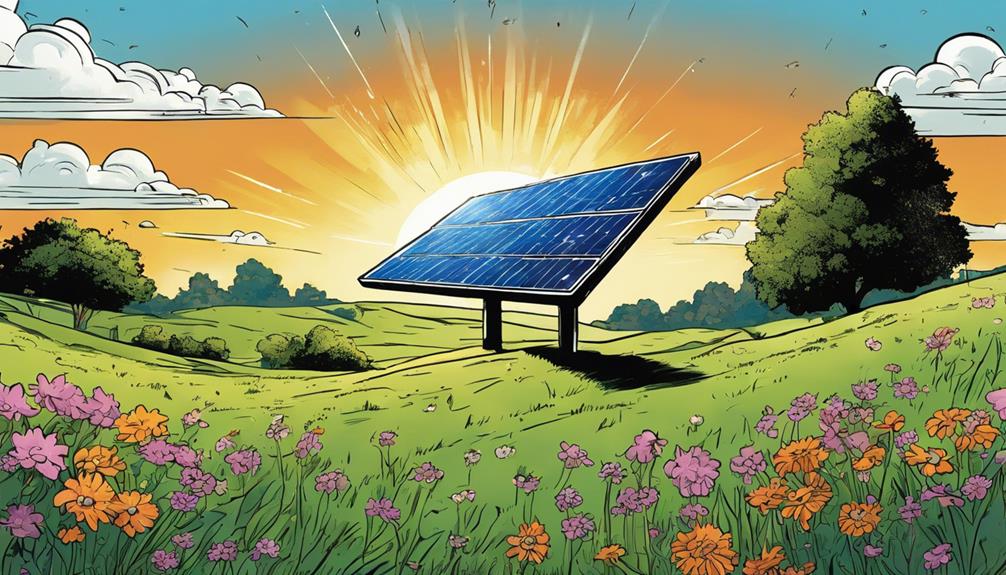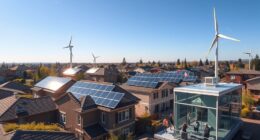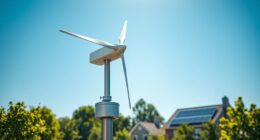You can expect a top-notch solar panel to transfer a significant amount of energy, with some panels capable of generating up to 400 watts per hour in ideal conditions, and commercial installations potentially producing even more. Factors like panel efficiency, temperature, shading, and maintenance impact energy production. To maximize energy transfer, it's essential to understand these factors and how they interact. By selecting high-efficiency panels and optimizing installation and maintenance, you can boost energy output. Now that you know the potential of solar panels, discover how to tap into their full energy-transferring potential.
Key Takeaways
- Solar panels can transfer 370-400 watts per hour in ideal conditions, with commercial panels reaching up to 500 watts.
- Energy output is linked to the power ratings of panels, with top brands offering ratings between 430-440 watts.
- Efficiency determines conversion of sunlight to energy, with premium panels achieving 20%+ efficiency.
- Factors like location, orientation, shading, and temperature influence panel efficiency, affecting energy transfer.
- Real-world energy production estimates vary based on sunlight intensity and panel quality, with residential panels transferring 7,000-10,000 kilowatt-hours per year.
Understanding Solar Panel Efficiency
When you invest in a solar panel system, understanding solar panel efficiency is important because it directly impacts the amount of electricity you can generate from sunlight. In essence, solar panel efficiency refers to the amount of sunlight that can be converted into electricity.
High-quality solar panels can have efficiency ratings of 20% or more, which means they can convert a significant amount of sunlight into power.
You want to maximize energy production and savings from your solar panels, and efficiency plays a vital role in achieving that. By understanding how efficient your solar panels are, you can determine how much energy they can transfer. This, in turn, affects how much electricity you can generate and use in your home or business.
To get the most out of your solar panel system, it's essential to focus on maintaining high efficiency. This involves regular maintenance, optimal placement, and investing in high-quality panels. By doing so, you can ensure that your solar panels transfer energy efficiently, providing you with a reliable source of power.
Factors Affecting Energy Transfer

Now that you understand how solar panel efficiency works, it's time to explore the factors that affect energy transfer.
You'll find that the panel's efficiency rate, temperature impact factor, and shading effects analysis all play a significant role in determining how much energy is transferred.
Panel Efficiency Rate
Your solar panel's efficiency rate plays a significant role in determining how much energy it can transfer, with high-quality panels boasting rates of over 22% and lower-quality ones struggling to reach 15%. This rate has a notable impact on the amount of energy your panel can transfer, and understanding it's essential for optimizing your system's performance.
Factors such as temperature, shading, and dust accumulation can affect your panel's energy transfer efficiency, but high-quality panels with efficiencies of 20% or more can still transfer more energy compared to lower-efficiency panels.
To maximize your panel's energy transfer, regular maintenance is vital. Cleaning your panels and minimizing shading can help optimize energy production and increase your savings.
By understanding your panel's efficiency rate and the factors that affect energy transfer, you can take steps to guarantee your system is running at its best, resulting in increased electricity production and savings.
Temperature Impact Factor
Rising temperatures can slash your solar panel's energy transfer capabilities, with every degree Celsius increase resulting in a 0.5% decline in performance. This means that higher temperatures can greatly reduce the energy output of your solar panel system. But why does this happen?
It's because temperature affects the performance of photovoltaic cells, which are the heart of your solar panel. As temperatures rise, the cells become less efficient, leading to a decrease in energy transfer.
Here are some key points to keep in mind:
- Higher temperatures reduce solar panel efficiency and energy output
- Solar panels operate most efficiently at cooler temperatures, maximizing energy transfer
- Understanding temperature effects is vital for optimizing energy production and system performance
- Every degree Celsius increase in temperature results in a 0.5% decline in performance
Shading Effects Analysis
Shading can be a major energy thief, sneaking up on your solar panel system and slashing its energy output by blocking sunlight from reaching the photovoltaic cells. You might think it's just a minor issue, but even partial shading on a small area of a solar panel can have a significant impact on energy production. Factors like trees, buildings, or debris causing shading can lead to energy losses in solar panels.
To give you a better idea, here's a breakdown of the impact of shading on solar panel energy output:
| Shading Percentage | Energy Loss | Energy Production |
|---|---|---|
| 10% | 20% | 80% |
| 20% | 35% | 65% |
| 30% | 50% | 50% |
| 40% | 65% | 35% |
| 50% | 80% | 20% |
Fortunately, you can mitigate shading effects by optimizing your solar panel placement and using systems with optimizers or microinverters. By monitoring shading patterns throughout the day, you can optimize your solar panel placement for maximum energy transfer. Don't let shading steal your energy – take control and maximize your solar panel's energy output!
How Solar Panels Generate Electricity
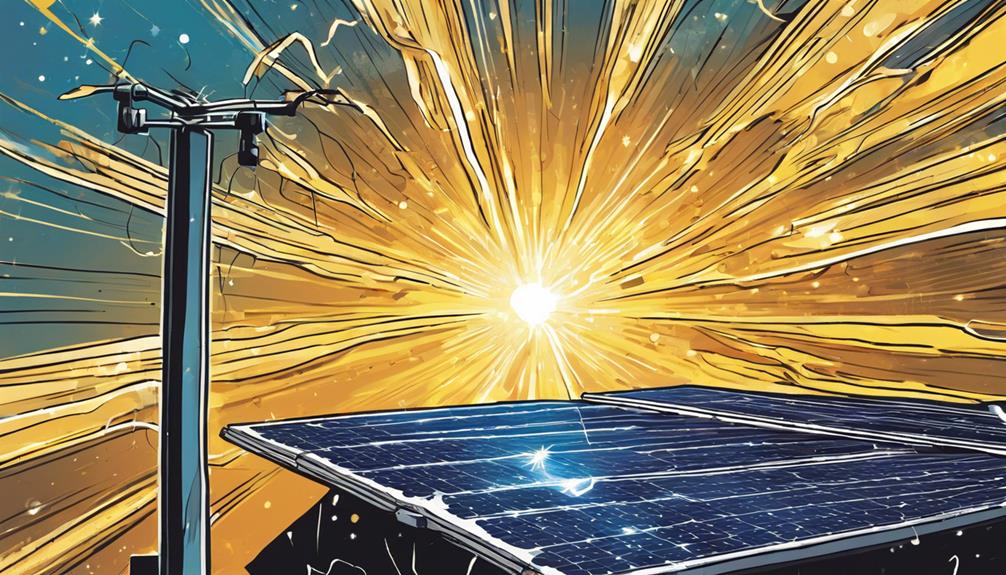
As you explore the world of solar energy, you'll find that solar panels generate electricity by harnessing the power of sunlight through a fascinating process. At the heart of this process are photovoltaic cells, which convert sunlight into electrical energy.
Here's how it works:
- Photovoltaic cells absorb photons from sunlight, creating an electric current that powers electrical devices.
- The amount of electricity a solar panel can produce depends on factors like sunlight intensity, panel efficiency, and system size.
- Solar panels can typically transfer around 370-400 watts per hour in ideal conditions, with commercial panels reaching up to 500 watts.
- Understanding how solar panels generate electricity is essential for maximizing energy production and optimizing system performance.
Measuring Energy Conversion Efficiency

You need to know how efficiently your solar panel converts sunlight into usable electricity, and that's exactly what energy conversion efficiency measures. This percentage indicates how well your panel can harness sunlight and turn it into power for your home.
Typically, solar panel efficiency ranges from 15% to 22% for most residential panels. However, premium solar panels can achieve efficiencies of 20% or higher, maximizing energy conversion.
Higher efficiency panels can generate more electricity from the same amount of sunlight, making them a worthwhile investment. Understanding a solar panel's energy conversion efficiency is essential for optimizing energy production and savings.
When selecting a solar panel, look for higher efficiency ratings to get the most out of your investment. By choosing a panel with high energy conversion efficiency, you'll be able to generate more power and reduce your reliance on traditional energy sources.
Technical Methods for Improvement

By employing advanced techniques, including anti-reflective coatings and rear surface passivation, you can greatly enhance the efficiency of your solar cells. These methods allow you to optimize energy conversion and maximize the amount of energy your solar panel can transfer.
To further improve solar panel efficiency, consider the following:
- Optimize fill factor by mitigating dust accumulation and ensuring maximum power point tracking for your PV cells.
- Utilize thin film materials and tandem cell structures to boost energy conversion rates.
- Implement radiative cooling technology to reduce heat buildup and enhance solar absorbers.
- Employ smart light management techniques to optimize energy conversion and reduce losses.
Solar Cell Efficiency Enhancement

Solar cell efficiency enhancement is a multifaceted approach that builds upon the technical methods for improvement, focusing on optimizing individual components to maximize energy conversion rates. As you explore ways to boost solar cell efficiency, you'll find that several techniques can make a significant impact.
| Technique | Description | Impact on Efficiency |
|---|---|---|
| Radiative cooling | Reduces temperature increases | Up to 1% increase |
| Rear surface passivation | Enhances efficiency through PERCs and dielectric layers | Up to 2% increase |
| Anti-reflective coatings | Minimizes sunlight reflection, maximizing absorption | Up to 3% increase |
| Thin film materials and tandem cells | Offers promising avenues for increasing efficiency | Up to 5% increase |
Energy Output in Ideal Conditions
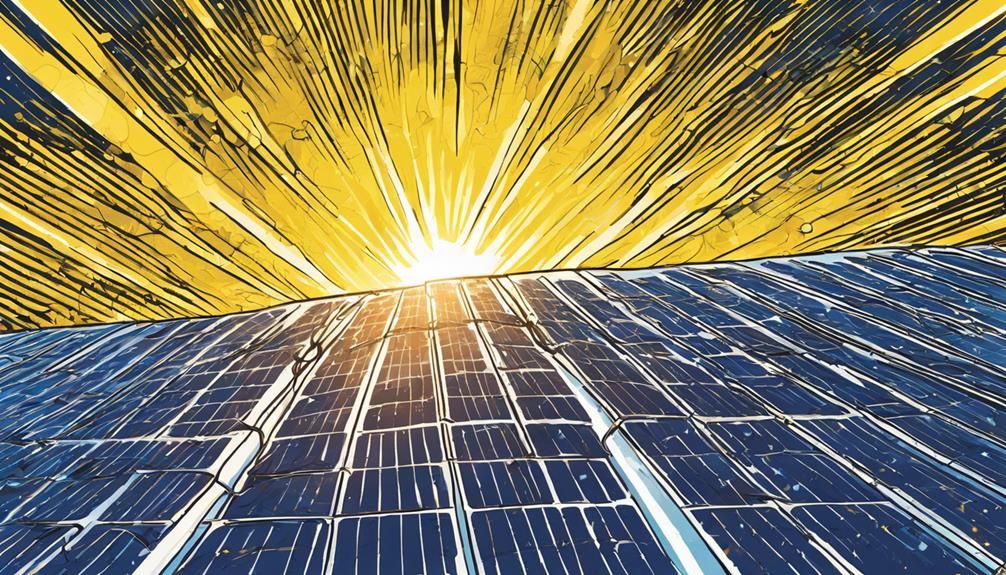
As you explore the energy output of a solar panel in ideal conditions, you'll want to understand what those ideal conditions are and how they impact the panel's performance.
You'll discover the maximum energy output a panel can achieve when everything is working in its favor.
Let's break down the key factors that contribute to a solar panel's peak power rating, starting with the definition of ideal conditions.
Ideal Conditions Defined
In ideal circumstances, you can expect most solar panels to produce between 370-400 watts of power per hour, with some high-performance models reaching up to 500 watts. This means that top solar panel brands can offer panels with power ratings ranging from 430-440 watts. However, it's important to understand that ideal conditions aren't always met in real-world situations.
Several factors influence solar panel energy production, including:
- Location: The amount of sunlight your location receives
- Orientation: The direction and tilt of your solar panels
- Shading: Any obstacles blocking sunlight from reaching your panels
- Efficiency: The capacity of your solar panels to convert sunlight into energy
Keep in mind that solar panel efficiency can be affected by temperature, shading, dust accumulation, and sunlight angle. To maximize energy production, it's vital to take these factors into account when installing and maintaining your solar panels.
Maximum Energy Output
You can anticipate your solar panel system to produce its peak energy output when ideal conditions are met, with most panels generating between 370-400 watts of power per hour. This energy output is directly linked to the power ratings of your solar panels, which can vary depending on the brand and model.
Top brands offer panels with power ratings ranging from 430-440 watts, while commercial installations may use panels with 500-watt power ratings. However, it's crucial to bear in mind that your solar panel's energy output also depends on factors such as location, orientation, and shading.
The efficiency of your solar panels can be influenced by temperature, with high temperatures potentially reducing energy output. Additionally, shading, dust, and sunlight angle can also affect the efficiency and energy output of your solar panels.
To maximize your energy output, it's important to take into account these factors when installing and maintaining your solar panel system. By doing so, you can make sure you're getting the most out of your solar panels and enjoying the benefits of renewable energy.
Peak Power Rating
Your solar panel's peak power rating represents its maximum energy output in ideal conditions, typically ranging from 370 to 400 watts per hour. This rating indicates the panel's energy production capabilities when exposed to best sunlight, temperature, and other environmental factors. However, it's important to note that actual energy output may vary depending on factors like location, orientation, and shading.
Here are some key points to keep in mind about peak power ratings:
- Commercial solar installations often use panels with higher ratings, such as 500 watts per hour.
- Top solar panel brands offer power ratings between 430 to 440 watts, demonstrating high efficiency.
- High-quality solar panels can achieve efficiencies of 20% or more, maximizing energy transfer capabilities.
- Ideal conditions for energy production aren't always met in real-world scenarios, so it's vital to take into account other factors that impact energy output.
When selecting a solar panel, understanding its peak power rating can help you make an informed decision about its energy production potential. Keep in mind that actual energy output may differ from the peak power rating, and take into consideration factors like efficiency, location, and orientation to get a more accurate estimate.
Real-World Energy Transfer Scenarios

As you ponder setting up solar panels, understanding how they perform in different real-world scenarios is vital.
You might question how much energy transfer happens in a typical residential solar panel system. The answer is approximately 7,000 to 10,000 kilowatt-hours of electricity per year.
Commercial installations, on the other hand, can employ high-efficiency panels with power ratings ranging from 430 to 440 watts, resulting in increased energy production.
However, it's important to take into account factors like location, orientation, shading, and panel efficiency, which impact the amount of energy transferred through a solar panel.
Under ideal conditions, solar panels can output an average of 370 to 400 watts per hour. But in reality, energy production estimates vary based on sunlight intensity, duration, and the quality of the panels used.
Understanding these real-world energy transfer scenarios will help you make informed decisions when selecting and setting up a solar panel system that meets your energy needs.
Frequently Asked Questions
What Is the Maximum Power Transfer on a Solar Panel?
You're wondering what the maximum power transfer on a solar panel is – it's determined by its wattage rating, typically ranging from 250 to 400 watts for residential panels, and can be calculated using the formula P = V x I. In this formula, P represents the maximum power output in watts, V represents the voltage, and I represents the current. Maximizing power transfer involves finding the optimal combination of voltage and current. This is crucial for ensuring the efficient conversion of solar energy into usable electricity. This concept is similar to the process of plant cell energy collection, where the plant’s cells must efficiently capture and convert sunlight into chemical energy for growth and development.
How Much Energy Is Converted by Solar Panels?
You're curious about how much energy solar panels convert – well, they typically turn 15-22% of sunlight into usable electricity, with high-efficiency panels reaching up to 23% conversion rates, depending on factors like sunlight intensity and panel orientation.
What Is the Energy Transfer of a Solar Panel?
You're curious about the energy transfer of a solar panel, and rightfully so! It's like opening a treasure chest of clean power. The answer is, a standard residential panel typically transfers around 300-400 watts of energy per hour, depending on various factors.
How Much Energy Can Be Supplied by Solar Energy?
You're wondering how much energy can be supplied by solar energy? Well, you can expect a typical solar panel system to supply around 7,000 to 10,000 kilowatt-hours of electricity per year, depending on factors like sunlight and panel quality.
Conclusion
As you harness the sun's mighty power, remember that even the most efficient solar panels can't catch every photon that comes their way.
But, just as Apollo's chariot rode the sun's rays to illuminate the world, your solar panel can ride the waves of energy to power your life.
With every improvement in technology, the gap between ideal and real-world energy transfer narrows, bringing us closer to a brighter, more sustainable future – one where the sun's energy is truly at our fingertips.




